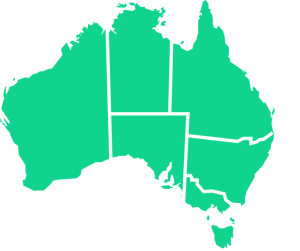The year 2024 was characterised by strong global growth, impressive double-digit returns across multiple asset classes, and a remarkable ability of major economies to sidestep recessionary pressures. In 2025, the focus shifts to whether this extraordinary momentum can be sustained. With central banks advancing their monetary easing cycles, the challenge will be engineering a ‘soft landing’ amid ongoing disinflation and a persistently tight labour market.
United States - A Dominant Force
The United States is well-positioned to lead global markets again in 2025, propelled by a broad-based expansion across industries, strong GDP growth, robust corporate earnings, relaxed regulations, and lower interest rates.
These factors reinforce the US as the dominant force in global capital markets. Investors who maintained an overweight position in US equities reaped significant benefits in 2024—the US market surged 25% compared to Australia’s market 7.5% (with dividends 11.2%).

The first half of 2025 is shaping up to be anything but typical, with President Trump’s second term bringing a wave of policy shifts—deregulation, large-scale deportations, and new tariffs. The Trump administration is creating an environment that strongly favours corporations, driven by policies supporting deregulation, mergers and acquisitions, tax cuts, and the onshoring of production. With 11 billionaires among Trump’s cabinet members, pro-business policies are expected to take centre stage. Around 80% of the portfolio remains allocated to US investments, reflecting confidence in the country’s economic trajectory.
Earlier this month, President Trump introduced new tariffs on Mexican and Canadian imports, only to postpone their enforcement shortly thereafter. This back-and-forth created significant market turbulence, akin to a rollercoaster ride. Despite the uncertainty, some investors view these trade-related fluctuations as potential entry points, expecting economic expansion to continue to be the dominant narrative in 2025, driving further stock market gains.
Artificial Intelligence (AI) - A New Phase
After dominating investment narratives in 2024, artificial intelligence is now shifting into a phase of commercialisation and monetisation, setting the stage for the next wave of market expansion. Last year, AI stocks posted extraordinary gains—Nvidia (NASDAQ: NVDA) alone soared 171%, significantly outpacing the broader S&P 500’s 25% return.
However, just a few weeks ago, DeepSeek, an AI company based in China, unveiled a brand-new model capable of rivalling the world’s leading AI systems but at a fraction of the cost and computing power. This immediately shattered long-held assumptions about the expense and infrastructure required to develop cutting-edge artificial intelligence – sending investors and multinational giants scrambling to reassess the future of the technology.

In just two years, DeepSeek has emerged as a formidable competitor in the AI space, challenging industry giants like OpenAI, Google, and Anthropic.
Its most impressive achievement to date is the DeepSeek-R1 model, which has surprised analysts by matching the performance of advanced models like GPT-4 at a fraction of the development cost. Unlike OpenAI and Google, which have poured billions into their AI efforts, DeepSeek claims to have built its model for just $5.6 million. Even more astonishing is that this was accomplished using only 2,048 Nvidia H800 chips—far fewer than the sprawling supercomputing clusters deployed by Western AI labs.
DeepSeek has also embraced an open-source approach, allowing developers worldwide to access, modify, and build upon its model. This stands in stark contrast to OpenAI and Google, which have opted to keep their most powerful AI technology proprietary.
The company’s success challenges the widely held belief that AI dominance is solely a function of massive capital investment. If DeepSeek can deliver cutting-edge AI at a fraction of the usual cost, it raises serious questions about the prevailing AI investment narrative—one that assumes only the biggest, wealthiest players can compete at the highest level. That said, we are still in the early stages of understanding the impact of DeepSeek and whether it is in fact a game changer.
Power Generation
As digital transformation and automation accelerate, investment opportunities are broadening beyond the leading players. At the same time, the surging energy demands driven by AI adoption underscore the urgent need for scalable and cost-effective energy solutions.
In 2025, AI is evolving from its early adoption phase into a more deeply integrated force across industries, driving meaningful innovation and efficiency. No longer confined to narrow applications, AI is now being embedded into complex workflows, enhancing productivity, decision-making, and operational effectiveness. This next stage of adoption is poised to reshape key sectors, including healthcare, manufacturing, and financial services.

In manufacturing, AI-powered automation and real-time data analytics are optimising production processes, improving efficiency, and reducing costs. The healthcare industry is leveraging AI to refine diagnostics, personalise treatment plans, and enhance patient outcomes. Meanwhile, financial services are increasingly utilising AI for predictive analytics, risk management, and fraud detection. As these capabilities expand, AI’s influence is becoming more widespread and deeply entrenched across the economy.
With AI workloads expanding at an unprecedented rate, infrastructure investment is surging to keep pace. Between 2025 and 2027, global spending on data centres and power generation is expected to exceed $1.5 trillion, with AI-related infrastructure accounting for more than half of that figure. As AI’s energy demands continue to skyrocket, the need for sustainable, high-efficiency power solutions has never been more urgent.
AI-optimised data centres are consuming vast amounts of electricity—so much so that they are beginning to strain residential power grids. As data centre energy consumption is projected to grow exponentially over the coming decade, the intersection of AI and the power sector is becoming a critical focus of technological and economic transformation.
The push for energy security and decarbonisation has put renewable and alternative energy sources at the centre of this “power race.” Among them, nuclear energy stands out as one of the safest, cleanest, and most reliable sources of low-carbon electricity. Given its ability to provide continuous, high-output power, nuclear energy is an ideal solution for AI data centres that require near-constant uptime.
Major tech players have already recognised this potential. In 2024, industry giants like Microsoft, Amazon, and Google—three of the world’s largest hyperscalers—made substantial investments in nuclear energy, underscoring its growing role in AI infrastructure. As we enter 2025, opportunities within the nuclear power value chain are set to expand further, driven by increased corporate commitments and growing government support for clean, scalable energy solutions.
China - Renewed Investor Optimism
Over the past month alone, China’s equity markets have surged by approximately $1.3 trillion (AUD $2.1 trillion) in value, as hedge funds have ramped up their buying at the fastest pace in months, largely in response to the excitement surrounding DeepSeek’s breakthrough.
This wave of investment has propelled the MSCI China Index into bull market territory—gaining over 20% from its cyclical low—while also making Hong Kong’s Hang Seng Index one of the best-performing share markets globally this year.

Analysts at Goldman Sachs expect the momentum to continue, forecasting a 16% rise in the MSCI China Index to 85 points over the next 12 months and a 19% jump in the CSI 300 Index to 4,700. Goldman Sachs estimates that this technological leap could enhance corporate earnings in China by 2.5% annually over the next decade, driven by productivity improvements, cost efficiencies, and new revenue streams. As AI-driven advancements reshape industries, investor confidence in China’s market strengthens, positioning it as a key player in the next phase of global technological and economic growth.
Investing in Chinese stocks comes with inherent risks, largely due to the unpredictable nature of the country’s regulatory environment. The Chinese government frequently adjusts its policies, creating volatility that can significantly impact investors. Sudden and sweeping regulatory crackdowns have affected major industries such as technology, education, and real estate, erasing billions in market value from once-thriving companies.
For instance, in 2021, China effectively banned online for-profit tutoring, crippling a multi-billion-dollar industry overnight and displacing thousands of native-English-speaking digital nomads. Similarly, tech giants like Alibaba and Tencent have faced hefty fines and restrictions as part of a broader antitrust campaign.
Closer to Home
In Australia, the strong share market performance of 2024, primarily propelled by major banks, may give way to more measured gains in 2025. Elevated valuations—where the Australian market is trading around 20 times earnings—along with reliance on fiscal policy and economic headwinds from a slowing domestic economy and weaker Chinese growth could present challenges.
Australia has remained among the few nations to maintain interest rates at post-pandemic levels, aiming to curb inflation over the long term despite sustained high living costs. However, on Tuesday, the Reserve Bank of Australia announced a quarter-point rate cut, indicating confidence in the economy’s stability and its ability to support lower costs.

Some analysts anticipate another rate reduction in May following the federal election. Historically, after three consecutive rate cuts, stock markets and real estate sectors tend to experience notable gains.
That said, geopolitical instability, trade disputes, and tariff uncertainties may add layers of risk, making diversification increasingly crucial. To navigate these conditions, investors might turn to defensive strategies, such as commodity exposure (particularly gold) or income-focused approaches like covered call strategies, to strengthen portfolio resilience in 2025.

Tony Raikes
CPA. B.Acc Dip.FP Grad.Cert.Mgt
Private Client Advisor
Authorised Representative No. 00448193
Prince Wealth Founder and Financial Adviser Tony Raikes utilises a variety of advanced risk management strategies to protect clients’ portfolios and is dedicated to providing a comprehensive financial planning experience, empowering clients to make confident and informed decisions about their financial future.



